Tokyo Underground
The Construction Series > Earthquake >Small > Ginza > Circular > Earth > Underground
If someone refers to the Captain
as “going underground,” the typical connotation
is that of the sleuth snooping through a seedy burg or random
less-than-reputable establishment. Certainly his exhaustive
survey last week of the Lip
and Hip “high quality touch club" in Kabukicho,
where shrewd negotiation cut the entrance fee by two-thirds,
would be a perfect example.
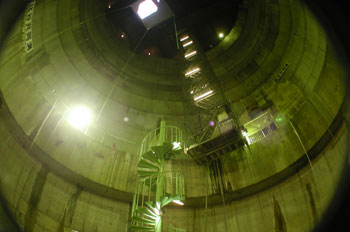 But
this week the
Captain is literally heading under Tokyo’s surface,
40 meters to be exact. Glance over his shoulder as he inspects
a massive Tokyo utility project that purports to be making
the city a safer and more enjoyable place.
But
this week the
Captain is literally heading under Tokyo’s surface,
40 meters to be exact. Glance over his shoulder as he inspects
a massive Tokyo utility project that purports to be making
the city a safer and more enjoyable place.
It is a typical central Tokyo
intersection. Office workers shuffle out of coffee shops;
cheap suit outlets troll for customers with fancy window
displays; taxis
and buses clog the roads from curb to median; and a construction
site - as all intersections in this modern metropolis seemingly
require - sits on one corner, white fencing surrounding the
property.
But this intersection in Toranomon is special
in a particular way: no column, scaffold, concrete mixer, or other
standard evidence of work ever shows itself from behind the
construction site's enclosure. The reason can be found below
- way below - ground level.
Stepping past the barrier and descending a
narrow spiral staircase to a temporary platform reveals Tokyo's
literal underworld. It is a stunning 20-meter diameter concrete
cylinder extending down for 40 meters. Light green hues reflecting
off the smooth concrete from mounted lights fill the scene
as workers move in and out of a temporary trailer and up and
down the single steel-cage elevator.
The
project, titled the Azabu-Hibiya Common Utility Duct
is a public works venture under the Ministry of
Land, Infrastructure and Transport that collects various utility lines into
a single trunk tunnel. Not only are Tokyo¹s endless streams of overhead wires slowly being reduced as a part of an effort to decrease earthquake susceptibility, the stunning scene makes for a unique tourist attraction.
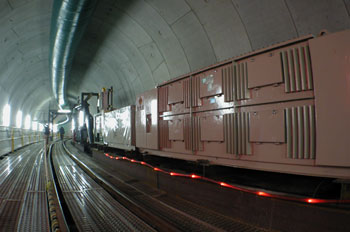 A report provided by the Tokyo National Highway Office said that after the 7.3-Richter magnitude Kobe earthquake in 1995, which killed more than 6,000 people, similar ducts tended to move along with earth pressures and suffered little damage.
A report provided by the Tokyo National Highway Office said that after the 7.3-Richter magnitude Kobe earthquake in 1995, which killed more than 6,000 people, similar ducts tended to move along with earth pressures and suffered little damage.
The existence of a single underground "lifeline" during these times, the Ministry says, will increase the chances that vital services will continue to be supplied at the time of the disaster. By contrast the Kobe quake resulted in utility services going down. As well, emergency vehicles
being restricted access to troubled areas by downed and entangled
utility lines.
The Japanese Cabinet office's Central Disaster Management Council issued a report in December 2004 indicating that a major earthquake in Tokyo could result in 13,000 deaths and the destruction of 850,000 buildings.
A 2004 study by the Earthquake Research Committee indicated that there is a 70 percent chance that Tokyo will be hit by a major tremor within the next 30 years. The Great Kanto Earthquake of 1923 was the last large quake to strike Tokyo. About 140,000 people died amid falling buildings and subsequent fires.
Over 100 kilometers of roadway in Tokyo have been given similar treatment. Under Route 246, a completed duct that stretches from Aoyama to Akasaka has been in operation for 20 years. Plans are set for an additional 1,000 kilometers throughout the metropolis.
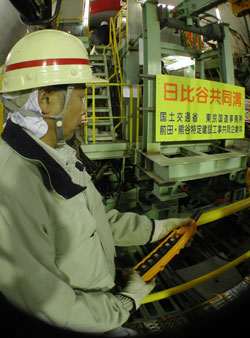 Public works projects are typically shrouded in secrecy. But this project is different.
Public works projects are typically shrouded in secrecy. But this project is different.
"A lot of Japanese citizens have this
idea that public works projects are not for the public,”
says Kiyotaka Yamana, who under the Tokyo Geo-Site Project promotional moniker arranges public tours and encourages
general awareness. “They (public works projects) are
notorious for having negative images attached to them. I am
trying to let the public know why they exist and what they
are being used for."
By
presenting these concrete works as fully open tourist attractions,
Yamana can show the public that taxpayer money is not literally being flushed down the drain.
During the two-hour tours, held a few times each year, visitors strap on
protective helmets and walk through a section of a completed
segment. The experience is similar to entering a science fiction
movie set; machines clank and hum as visitors proceed down
illuminated concrete arteries that appear to continue forever.
Colorful displays and placards along the path
tell the story of how the work has been performed. A handful
of the workers are on hand to answer questions.
Yamana
is always looking for “friendly” events to attract
visitors. Traditional Japanese theater performances have been
staged on a makeshift stage atop the bottom of the shaft.
As well, votive lights have been strewn along the tunnel floors
to create candlelit walks. Included among the visitors to
this subterranean world have been television crews and film-makers.
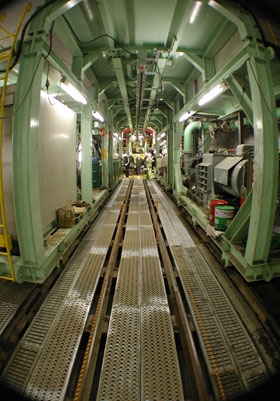 With the public associating public works with
past financial
busts like the Aqualine toll expressway - one of many
recent examples of bureaucrats citing inflated demand projections
to justify large project budgets - Yamana is trying to develop
a sense of openness to a practice that has typically been
very opaque.
With the public associating public works with
past financial
busts like the Aqualine toll expressway - one of many
recent examples of bureaucrats citing inflated demand projections
to justify large project budgets - Yamana is trying to develop
a sense of openness to a practice that has typically been
very opaque.
"Once people have a chance to visit, a
lot are amazed with what is inside, the size of the space,
the machines that are used, and the people who are doing the
work," Yamana explains.
Toranomon is the "launching shaft." The cylinder is a hub in which lateral utility tunnels emerge at its bottom in the directions of Azabu and Sakuradamon.
Theses tunnels are concrete-lined
by rings of reinforced concrete blocks, slightly curved to
fit into place around the walls. A large slurry tunneling machine,
with rows of teeth affixed to a rotating shield, bores its
way laterally through the generally sandy soil at a diameter that ranges from
five to seven meters.
The reinforced concrete blocks (about the size
of the tops of office desks) are pushed into place by jacks
attached to the back of the machine to form one ring of the
lining. Subsequent rings are added as the work, which follows
the centerline of the road above, continues laterally from
the hub. . Two hours is required to install a single ring.
A scaffold is then mounted slightly above the
bottom of the tunnels. In addition to providing a floor on
which workers can move, a center rail allows a train,
named “Pikachu,” to haul the blocks and various
bits of needed construction equipment as the work progresses
along the line.
The utility lines - such as gas, telephone, water, electric, and cable - are
designated by a specific color, are affixed along the walls.
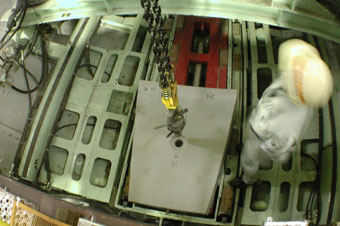 As the name implies, the project extends from
the Tokyo districts of Azabu to Hibiya. Toranomon is roughly
in the center. Construction, which began in 1989, was recently
completed for the 2.8-kilometer segment between Azabu and
Toranonon. The additional 1.5 kilometers for the Hibiya segment
is expected to be completed by 2010. The project’s budget
is 42 billion yen, which corresponds to roughly 10 billion
yen per kilometer of road.
As the name implies, the project extends from
the Tokyo districts of Azabu to Hibiya. Toranomon is roughly
in the center. Construction, which began in 1989, was recently
completed for the 2.8-kilometer segment between Azabu and
Toranonon. The additional 1.5 kilometers for the Hibiya segment
is expected to be completed by 2010. The project’s budget
is 42 billion yen, which corresponds to roughly 10 billion
yen per kilometer of road.
The number of workers required is minimal. Only four are needed to operate the boring machine, while the site might include 25 in total at any given time.
Work was delayed at Hibiya for a short period in 2001 when a pile driven below the surface for the construction of a retaining wall discovered 240 stones from the Hibiya Gate of Edo Castle.
Digging
for the Hibiya segment started last year. The work has extended a little more than
800 meters, nearly reaching the moat of the Imperial Palace.
This distance contains a slightly uphill slope to a depth
30 meters below the surface. For
reference, the Yurakucho subway line crosses nearby at about
15 meters below the surface. In later stages, the work will
take a ninety-degree turn at the moat and continue another
580 meters to Hibiya.
Other benefits of the project include: the disappearance of
overhanging lines makes the metropolis more pleasing to the
eye; utility line longevity is increased by the lack of exposure
to natural elements; and the reduction in costly excavation
eases maintenance and increases pedestrian and vehicle flow.
"In central Tokyo, a lot of road construction
is taking place, causing traffic jams,” Yamana says.
“Here, a common utility tunnel is being placed under
major areas so that if one cable is cut off or some other
problem happens, a workman can go underneath and do the repair
work without having to dig a trench."
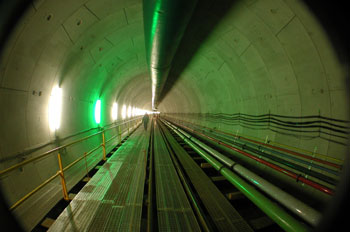 In
neighboring Saitama prefecture, Yamana likewise promotes the
Metropolitan Area Outer Discharge Channel under the
G-Cans Project title. This project, however, differs
slightly in scope from its Tokyo public works brother.
In
neighboring Saitama prefecture, Yamana likewise promotes the
Metropolitan Area Outer Discharge Channel under the
G-Cans Project title. This project, however, differs
slightly in scope from its Tokyo public works brother.
This 6.3-kilometer network is a series of inlets,
pumps, and massive underground concrete channels that funnels
rainfall runoff into the Edogawa River before it empties into
the Pacific Ocean.
For this project, Yamana has expectations that
reach beyond mere tours and theater shows; he wants to show
the world the appeal of Japan’s concrete
spectacle.
Spectacular pictures of large support columns and
meandering channels contained on the G-Cans Project
Web site have caught the attention of Life magazine and ABC
News (Australia). Yamana hopes Hollywood comes calling next.
"My dream,” he says, “is for
the next 'Die Hard' movie to have Bruce Willis
jogging through one of the concrete channels.”
Sweet concrete dreams…
Note: All photos taken during a tour of
"The Azabu-Hibiya Common Utility Duct."
The Construction Series > Earthquake >Small > Ginza > Circular > Earth > Underground

